All Nonfiction
- Bullying
- Books
- Academic
- Author Interviews
- Celebrity interviews
- College Articles
- College Essays
- Educator of the Year
- Heroes
- Interviews
- Memoir
- Personal Experience
- Sports
- Travel & Culture
All Opinions
- Bullying
- Current Events / Politics
- Discrimination
- Drugs / Alcohol / Smoking
- Entertainment / Celebrities
- Environment
- Love / Relationships
- Movies / Music / TV
- Pop Culture / Trends
- School / College
- Social Issues / Civics
- Spirituality / Religion
- Sports / Hobbies
All Hot Topics
- Bullying
- Community Service
- Environment
- Health
- Letters to the Editor
- Pride & Prejudice
- What Matters
- Back
Summer Guide
- Program Links
- Program Reviews
- Back
College Guide
- College Links
- College Reviews
- College Essays
- College Articles
- Back
Environmental Crisis
Currently, the world’s species of wildlife are depleting at a significantly increasing rate. Slightly less than half of the world’s original forests are still standing. This ongoing issue has resulted from causes mainly evolving around human existence leading to permanent effects such as habitat destruction and species extinction. Our dying environment needs to be assessed as soon as possible with conservation being our best option.
The increased human population over the years has lead to an increase in human activity. With more people populating the world results in a larger, more abundant amount carbon dioxide being released into the atmosphere. This pollution is known to be the trigger cause of a crucial sub-problem of the worlds depleting wildlife, Global Warming. A larger population also leads to a higher demand in the resources essential to human life, such as food and water. The manufacturing of food additionally contributes to the pollution of carbon dioxide, or greenhouse gasses, in the atmosphere. The world’s population has nearly doubled in the last hundred years, creating many causes of the dying life in the environment.
With such high rates of human activity, species extinction is the primary effect that has resulted. As anyone can tell you, numerous wildernesses are being destroyed for building purposes. Not only are the houses often built in an inconvenient location, but they are constructed as enormous million dollar homes, unfriendly to the environment. For example, a bigger house results in more electricity usage. Within these homes are what are known as phantom energy users or energy wasting objects such as, lights, clocks, and kitchen appliances. Greater usage of energy results in greater pollution. In addition, certain areas of the world are home to what are known as indigenous species. These species define forms of wildlife that can only survive in specific conditions. When indigenous habitats are destroyed the animals have no where to migrate to and eventually die out. Species extinction is the primary effect that has resulted from the rise in human activity.
Although this issue is extremely severe within our world today, it is not too late to act against it. Conserving in ways such as turning the lights off when you leave the room, or installing solar panels as a form of energy can help reduce the damage humans have on the environment. Reducing, reusing, and recycling, additionally has a lasting positive effect on the environment. By doing this, less of the earth’s natural resources would be harvested in a way that would still benefits human consumption patterns. The worlds’ environments need to reach a sustainable rate to last through the future.

Similar Articles
JOIN THE DISCUSSION
This article has 0 comments.
